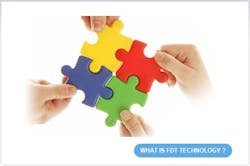Standardized Software Interfaces Enable Open and Flexible Automation Systems
In order to be open and flexible, a system must seamlessly integrate a wide range of automation components—including third-party components that round out the in-house product portfolio. From the end user's standpoint, it is important for engineering, commissioning, and maintenance to remain controllable and efficient. For the manufacturer, development costs for hardware and software play a key role. Development of the necessary software tools is a cost factor that must not be underestimated. Cost drivers here include support for various fieldbus and device specifications within the tools and their integration into other manufacturers' systems.
With FDT, software components can be grouped together into tools for various jobs. For instance, components for a fieldbus master and components for sensors and actuators can be integrated into a PLC programming system. Once the components are developed they can be used in various tools. This reuse ultimately saves development costs, even if the initial costs may be higher, since the components must be developed with various applications in mind.
How does FDT work?
FDT standardizes interfaces between tools so called Frame Applications and Device Type Managers (DTMs). DTMs are virtual representatives of physical automation components, which are plugged into the tools as needed (Figure 2).
A DTM is a component that represents fieldbus and device specifics in software and provides corresponding software and user interfaces. The first version of the FDT standard was defined in 2000 and was at the time based on Microsoft COM/ActiveX technology. Ten years of practical experience with the standard have gone into the current version, FDT2™. The standard is now based on the Microsoft .NET framework and is recognized as an international standard under IEC62453 and ISA103. FDT is also registered as an official standard in China under the designation GB/T 29618.
The basic idea of a DTM is that it is developed one time by the manufacturer of an automation component and then used in a wide range of tools for various tasks (Figure 3).
Example: DTM for a drive
Drive manufacturers are often suppliers of entire systems and individual components at the same time. In the first case, the drives must be represented in a PLC programming system, for instance, and in the second case, a simpler tool is needed for commissioning and maintenance.
The DTM for a drive typically provides a user interface for configuration. Figure 4 shows the use of a Schneider Electric Altivar drive in SoMove. SoMove is a simple commissioning and maintenance tool. The user selects the desired drive on the home screen. Subsequently, the drive-specific configuration interface provided by the Schneider Electric Altivar DTM appears.
If the Altivar DTM is used in the Schneider Electric SoMachine PLC programming software (Figure 5), the same DTM configuration interface is used. However, the programming software also uses the interfaces provided by the Altivar DTM to integrate the drive IO into the control program.
Integrating third-party components
The two previous examples show how a drive is integrated into different software tools made by the same manufacturer. In addition, FDT is also designed in particular to integrate components from different manufacturers into a single system. For this reason, the same mechanism as used before for the Altivar can be used to integrate additional sensor/actuator systems into SoMachine—an open system. All the manufacturer needs to do is provide the appropriate DTMs.
But not every manufacturer needs DTMs. For simple sensors and actuators, the usual description files (GSD, EDS, etc.) suffice. There are interpreter DTMs, or generic DTMs, as this type of DTM is sometimes called. They make it possible to integrate these types of components into an FDT system. The user interfaces here are simple and generic, but thoroughly adequate for many applications.
Summary
FDT is a tried-and-tested software interface for integrating automation components into software tools. The use of FDT creates open, flexible automation systems. Fieldbus and device specifications are represented by DTMs, which can be integrated into a wide range of tools. The user interfaces are thus identical in all tools. In the overall context, development costs are saved through reuse.
FDT Group
The FDT Group is an open, independent, non-profit association of international companies that have joined forces to further develop and establish the international FDT standard in the marketplace.
For more information, please visit: www.fdtgroup.org
About the Author
Manfred Brill & Frank Schmidt
Software Governance Senior Manager Schneider Electric Automation GmbH & Head of Consulting M&M Software GmbH - Members of the FDT Group's Executive Committee

Leaders relevant to this article:
